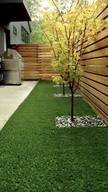Artificial Grass

Installing artificial grass
Installing artificial grass requires careful planning and execution to ensure a durable and aesthetically pleasing result. Here are some guidelines for installing artificial grass:
-
Prepare the Area: Remove any existing grass, weeds, rocks, or debris from the area where you plan to install the artificial grass. Level the ground and compact it to create a smooth and stable base.
-
Install Edging: Install edging around the perimeter of the area to contain the artificial grass. This can be made of materials such as plastic, metal, or wood and should be secured firmly in place.
-
Lay Base Material: Lay a base material such as crushed rock or decomposed granite to provide drainage and stability for the artificial grass. Spread the material evenly and compact it with a compactor or hand tamper.
-
Lay Weed Barrier: Lay a weed barrier fabric over the base material to prevent weeds from growing through the artificial grass. Secure the fabric in place with landscape staples.
-
Install Artificial Grass: Roll out the artificial grass over the prepared area, ensuring that it fits properly and lays flat. Trim any excess material as needed. If joining multiple pieces of grass, use adhesive or seaming tape to create seamless seams.
-
Secure the Grass: Secure the edges of the artificial grass with landscape staples or nails, making sure it is taut and properly anchored.
-
Infill (Optional): Spread a layer of infill material such as silica sand or rubber granules over the artificial grass to provide stability, support, and cushioning. Brush the infill into the grass fibers with a power broom or stiff brush.
-
Brush and Fluff: After installation, brush and fluff the artificial grass fibers with a stiff brush to help them stand upright and maintain their appearance.
As for the environmental impact of artificial grass, it has both pros and cons. On one hand, artificial grass does not require water, fertilizers, pesticides, or mowing, which can help conserve water and reduce chemical use. However, artificial grass is typically made from synthetic materials such as polyethylene or polypropylene, which are derived from petroleum and can take hundreds of years to decompose in a landfill. Additionally, the production and disposal of artificial grass can have environmental consequences.
In terms of who would do this type of installation, landscaping companies or contractors specializing in synthetic turf installations are typically responsible for installing artificial grass. While carpeting companies may have some experience with installing similar materials, it's best to hire professionals who specialize in artificial grass installation to ensure the job is done correctly.
When selecting a contractor, be sure to ask about their experience, credentials, and references. Request a detailed estimate that outlines the scope of work, materials to be used, and timeline for completion. By hiring a reputable and experienced contractor, you can ensure a successful artificial grass installation that meets your needs and expectations.
